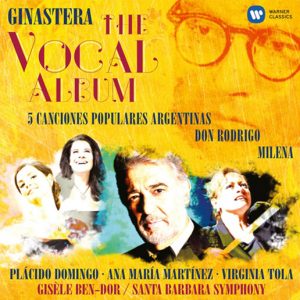Amazon Music, Huntley Dent
5.0 out of 5 stars
A superb centenary tribute to the great tango master
Reviewed in the United States on August 9, 2021
Just as the nocturne and the mazurka are synonymous with Chopin, the tango instantly brings to mind the name of Astor Piazzolla, whose centenary is being celebrated by this vibrant album titled simply Cien Años. Not many major composers adopted the tango (Stravinsky’s version in L’histoire du Soldat is so cool and detached it betrays the very nature of tango). It speaks volumes about the remoteness of South America from the minds of classical composers that the dumka and polonaise drew immense attention by comparison.
But once Piazzolla was discovered outside Argentina, no one has attracted more affection from a wide range of classical performers. The eroticism so dominant in tango dance programs doesn’t often seep through when Piazzolla makes it to Carnegie Hall, but he has so much to offer melodically, harmonically, and rhythmically that Eros is a side issue. No popular dance form besides the Viennese waltz has been as lucky in the sophistication that one genius brought to it. Piazzolla’s signature is indelible, and his music survives a wealth of arrangements and “derangements” (to borrow Thomas Beecham’s witty term) without losing its essence.
For all that, Piazzolla’s tangos have perhaps been passed from hand to hand too much for their own good, outside Argentina at least. Their foster homes in the U.S. and Europe haven’t always been congenial, which makes this new release stand out for sounding and feeling like the real thing. Piazzolla’s instrument was the bandoneon, and it occupies center stage on the program, played with undeniable charisma by Juanjo Mosalini, a recognized master of the instrument who was born in Buenos Aires in 1972 and whose career has an international reach.
In Western folk and popular music there are many varieties of bellows-driven reed instruments, each with its own character. The tango, to my ears, is inconceivable on Lawrence Welk’s accordion. Like the harmonica, the bandoneon is intimate and personal, but the harmonica in erotic mode is fairly laughable. The bandoneon has its own come-hither allure, and it can weave a melody as sinuously as the bodies of impassioned tango dancers. Piazzolla studied in Paris with Nadia Boulanger, and he created Nuevo tango as a malleable genre that fluidly crosses over between the concert hall and the dockside bars and clubs of Buenos Aires.
A beautiful aspect of Mosalini’s playing is his ability to inhabit every world Piazzolla’s music takes us to, from the swanky to the gritty. The most urbane work here is the Concerto for Bandoneón, often just called Aconcagua. The music is relatively refined, the earthiness and growl of the bandoneon tempered for civilized purposes. But tango is still palpable, as explained in the readable and helpful program notes: “Many of Piazzolla’s compositions begin with a riff, a jagged theme that repeats insistently. Most of them have an air of milonga, the ancestral music of Buenos Aires.” As related to the bandoneon concerto, “the underlying pulse undulates in groups of 3, 3, and 2 right from the opening statement.”
This off-balance rhythm gives tango its signature, and in the most famous work here, The Four Seasons of Buenos Aires, Piazzolla puts the basic rhythmic pulse through endless, fascinating changes, greatly aided by Mosalini’s arrangement for bandoneon and chamber orchestra—he adds punch to the accents and imbues the music with touches of his own personality. There are other arrangements by him on the disc, listed as world premieres, the most dazzling being an original composition, Tomá, Tocá, a bravura variant of a toccata in which he plays a Moto perpetuo in sixteenth notes while the tango melody is punched out as if by a third hand. Another of his pieces, Cien Años, the album’s title work, is tenderly reminiscent of smoky Parisian cafés at midnight, nodding to that strain of Piazzolla’s imagination.
As remarkable as Mosalini is, such an imaginative release owes just as much to , Gisèle Ben-Dor, the emeritus conductor of the Pro Arte Chamber Orchestra of Boston. Not only does she lead each piece with sympathy and a knowing hand, keeping the tango pulse alive and vibrant, but Ben-Dor commissioned Mosalini’s Cien Años and his arrangement of The Four Seasons. The latter alone is enough to make this release a significant addition to the burgeoning Piazzolla discography, given is originality and its inspired take on the original. All lovers of Piazzolla will be grateful to Ben-Dor for a project that has wound up being a superb listen.
Warmly recommended as one of the liveliest, most entertaining albums of the year.
Huntley Dent




